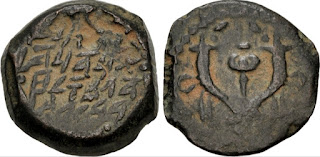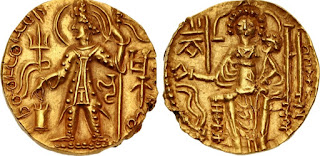Cornucopia is a well-known, and, on coins, often recurring symbol of abundance, fecundity, fertility and happiness. Derived from the latin ''cornu'' meaning ''horn'' and ''copiae'' meaning ''plenty'', it has long been used as a common harvest symbol. It is identified by some with the horn of Amalthea, the nurse of Jupiter, and from which horn fruits and flowers and all the riches of nature and art are represented. Others say that it is the horn which Hercules tore from the head of Archelous, in his encounter with that protean monster, and which the nymphs picked up and converted into the horn of plenty.
Ptolemaic Egypt, Arsinoe II, Philadelphus, 270-268 BC, AR Decadrachm.
Cornucopia, filled with fruits, or enclosed within a wreath, formed of corn-ears and flowers, appear either as a symbol of the monetary triumvirs, denoting the abundance of all the things, to be supplied by means of money, or as the symbol of the curule aediles.
Cornucopia appears in the fifth century BC, as an attribute of the god Hades. The ruler is represented with this object many times on vases of that time. From the fourth century BC, in the reliefs of Asclepeion Athens, Tyche is represented holding a cornucopia. This type of representation develops strongly in the Hellenistic period and then in Roman times. This ornament appears on a variety of antique monuments, both sculptural and numismatics. The cornucopia became the attribute of several Greek and Roman deities.
Statue of a Ptolemaic queen, perhaps Cleopatra VII, 200-30 BC, dolomitic limestone
The cornucopia was one of the most popular religious symbols of the ancient world and was commonly used on Jewish coins. Coins of the Ptolemaic Kings of Egypt, Seleucid Kings of Syria and a number of ancient Hellenistic city-states depicted cornucopia
In Roman coinage, many gods and personifications are represented holding the cornucopia. Abundantia, Africa, Asia, Aeternitas, Moneta, Annona, Ceres, Concordia, Fecunditas, Felicitas, Fortuna, Roma, Salus etc. It usually appears in two positions, either with the mouth or opening facing upwards or facing downwards, depending on the deity being portrayed.
In modern depictions, it is a hollow, horn shaped wicker basket filled with various kinds of festive fruit and vegetables. In Nort America it is associated with Thanksgiving and the harvest. The symbol is depicted in the flag and state seal of Idaho, the Coat of Arms of Colombia, Panama, Peru and Venezuela and the Coat of Arms of the state of Victoria and Australia.
Coat of Arms of Columbia
Coat of Arms of Peru
Coat of arms of Kharkiv, Ukraine
Aquilia Severa, Augusta, 220-221 AD, AR Denarius, Rome mint, struck under Elagabalus, Obverse: Draped bust right, Reverse: Concordia standing left, holding double cornucopia and sacrificing out of patera over lighted altar to left, star to right

















No comments:
Post a Comment
Any inputs or feedback is welcome!